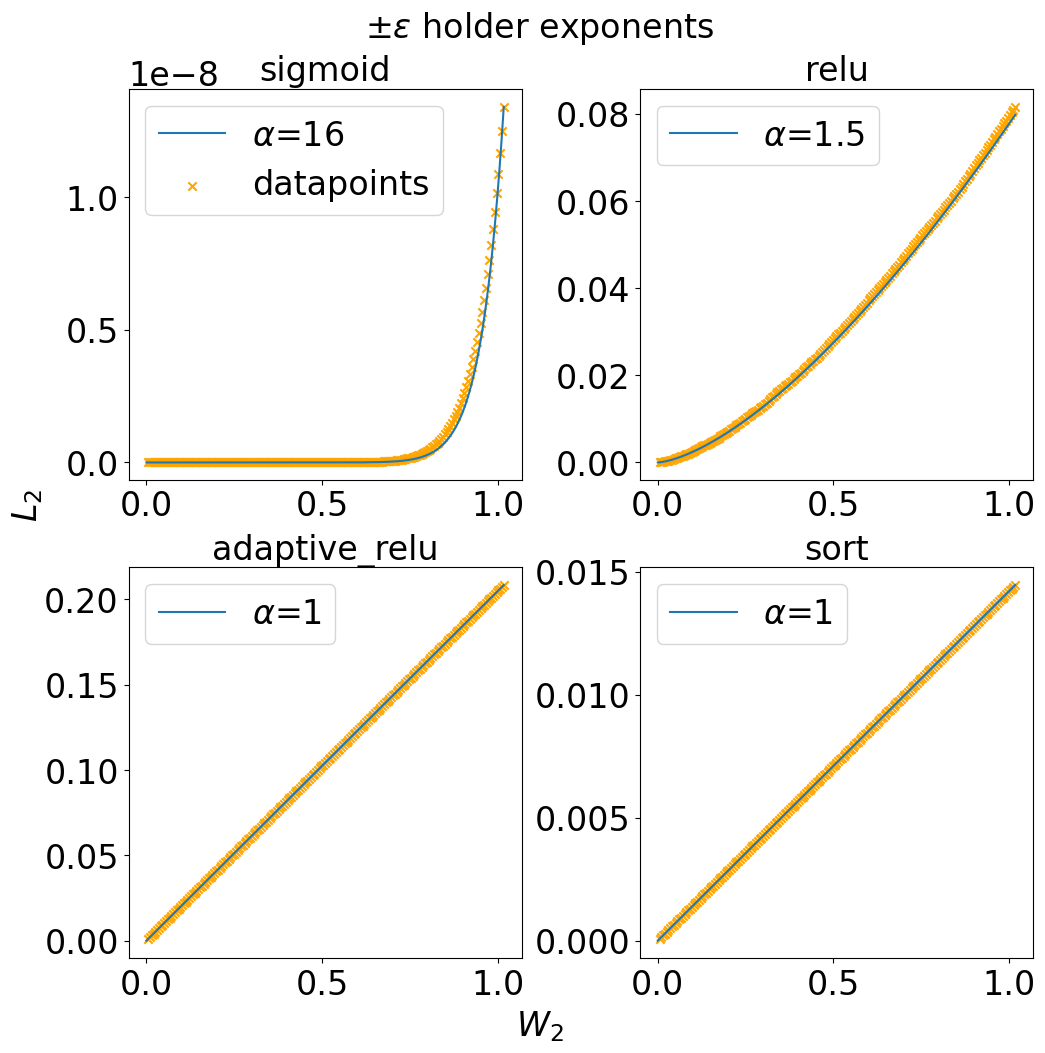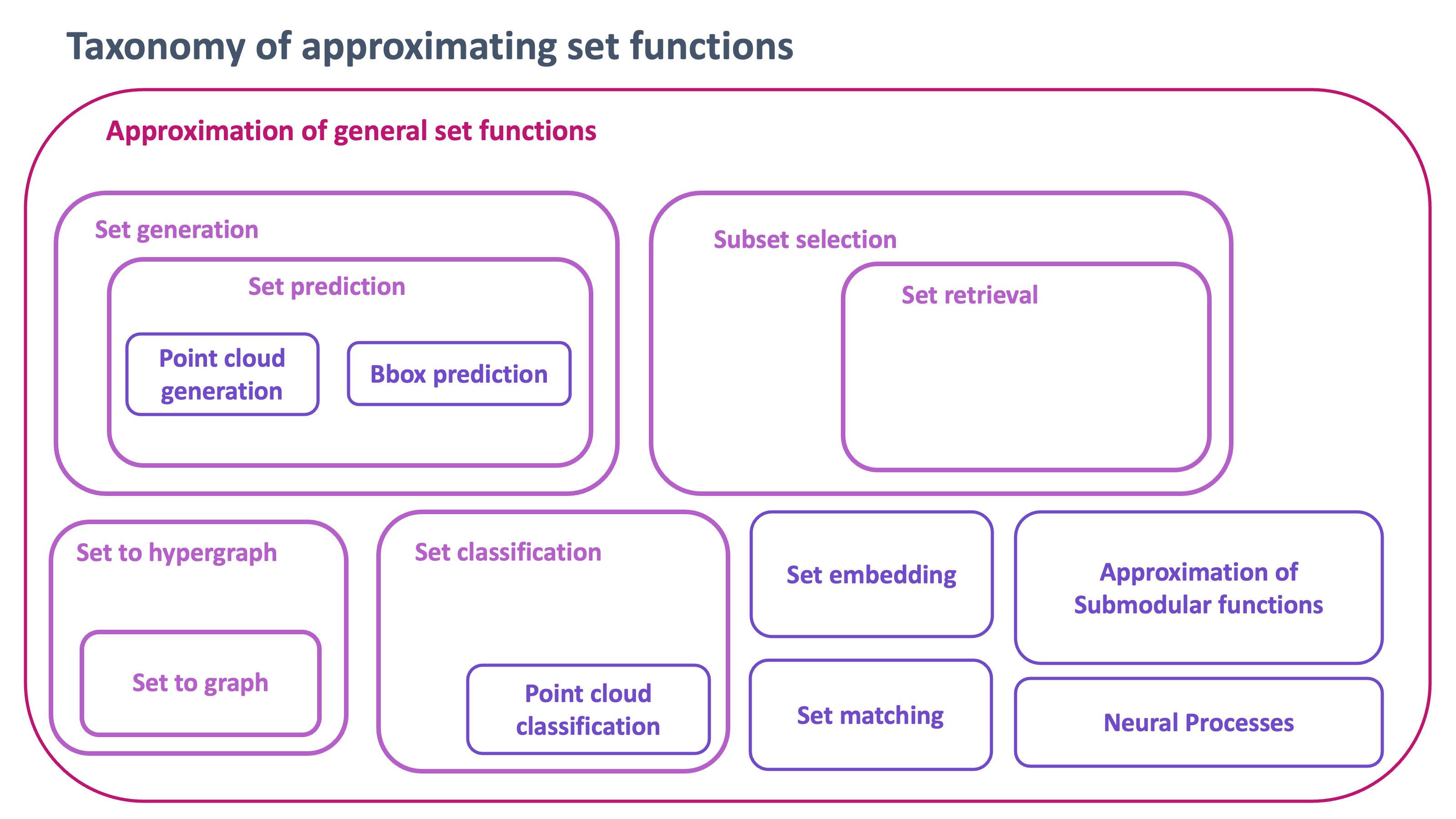On the H{o}lder Stability of Multiset and Graph Neural Networks
2406.06984

0
0

Abstract
Famously, multiset neural networks based on sum-pooling can separate all distinct multisets, and as a result can be used by message passing neural networks (MPNNs) to separate all pairs of graphs that can be separated by the 1-WL graph isomorphism test. However, the quality of this separation may be very weak, to the extent that the embeddings of separable multisets and graphs might even be considered identical when using fixed finite precision. In this work, we propose to fully analyze the separation quality of multiset models and MPNNs via a novel adaptation of Lipschitz and H{o}lder continuity to parametric functions. We prove that common sum-based models are lower-H{o}lder continuous, with a H{o}lder exponent that decays rapidly with the network's depth. Our analysis leads to adversarial examples of graphs which can be separated by three 1-WL iterations, but cannot be separated in practice by standard maximally powerful MPNNs. To remedy this, we propose two novel MPNNs with improved separation quality, one of which is lower Lipschitz continuous. We show these MPNNs can easily classify our adversarial examples, and compare favorably with standard MPNNs on standard graph learning tasks.
Create account to get full access
Overview
- This paper analyzes the Hölder stability properties of multiset and graph neural networks, which are machine learning models used to process data represented as sets or graphs.
- The main results show that these models can be Hölder stable, meaning their output changes continuously with small changes to their input.
- The paper also discusses connections to related work on generalization, continuity, and permutation invariance in neural networks.
Plain English Explanation
This research paper looks at how well certain machine learning models, called multiset and graph neural networks, can handle small changes in their input data. These models are designed to work with data that is represented as a set of elements (a multiset) or as a graph, where objects are connected to each other.
The key idea is that the output of these models should change in a continuous, predictable way when the input data is slightly modified. This is an important property called Hölder stability, which means the model's behavior doesn't drastically change with small tweaks to the input.
The paper shows that multiset and graph neural networks can indeed satisfy this Hölder stability condition under certain circumstances. This is significant because it suggests these models can generalize well and make reliable predictions, even when they encounter new or slightly different data than what they were trained on.
The researchers also connect their findings to other related work on the generalization abilities, continuity, and permutation invariance of neural networks more broadly. These concepts are all important for ensuring machine learning models behave robustly and reliably in real-world applications.
Technical Explanation
The paper investigates the Hölder stability of multiset and graph neural networks, which are models that can process data represented as unordered collections or as relational structures.
For multiset neural networks, the main result is that they can be Hölder stable with respect to the multiset distance, meaning their outputs change continuously when the input multiset is slightly perturbed. This generalizes prior work on the Lipschitz continuity of such models.
Similarly, for graph neural networks, the paper establishes Hölder stability with respect to the graphon distance, which quantifies how different two graphs are. This provides a theoretical guarantee on the robustness of these models to small changes in their graph-structured inputs.
The analysis draws connections to other important properties like permutation invariance and equivariance, which are desirable for models handling unordered data. The results contribute to a broader understanding of the generalization and continuity properties of neural networks.
Critical Analysis
The paper provides a rigorous mathematical analysis of the Hölder stability of multiset and graph neural networks, which is an important theoretical property for ensuring the reliability and robustness of these models. However, the analysis is limited to specific model architectures and assumptions, and may not fully capture the complexities of real-world data and applications.
One potential limitation is that the Hölder stability bounds derived in the paper may not be tight or easily computable in practice, reducing their direct practical value. Additionally, the paper does not address how these stability properties might be affected by common techniques like data augmentation or adversarial training, which could impact the models' behavior in unexpected ways.
Further research is needed to understand how these stability results generalize to more diverse neural network architectures and domains, as well as to explore the interplay between Hölder stability and other desirable properties like expressive power and sample complexity. Bridging the gap between theoretical analysis and practical performance remains an important challenge in the field of machine learning.
Conclusion
This paper makes important theoretical contributions to the understanding of multiset and graph neural networks by establishing their Hölder stability properties. This helps provide a mathematical foundation for the robustness and generalization capabilities of these models, which are crucial for their real-world deployment and trustworthiness.
The findings connect to a broader body of work on the continuity, permutation invariance, and generalization of neural networks, advancing our fundamental knowledge of these increasingly influential machine learning techniques. While the analysis has limitations, it opens the door for further research to deepen our understanding of the practical and theoretical aspects of neural networks for structured data.
This summary was produced with help from an AI and may contain inaccuracies - check out the links to read the original source documents!
Related Papers
🐍
Generalization Bounds for Message Passing Networks on Mixture of Graphons
Sohir Maskey, Gitta Kutyniok, Ron Levie

0
0
We study the generalization capabilities of Message Passing Neural Networks (MPNNs), a prevalent class of Graph Neural Networks (GNN). We derive generalization bounds specifically for MPNNs with normalized sum aggregation and mean aggregation. Our analysis is based on a data generation model incorporating a finite set of template graphons. Each graph within this framework is generated by sampling from one of the graphons with a certain degree of perturbation. In particular, we extend previous MPNN generalization results to a more realistic setting, which includes the following modifications: 1) we analyze simple random graphs with Bernoulli-distributed edges instead of weighted graphs; 2) we sample both graphs and graph signals from perturbed graphons instead of clean graphons; and 3) we analyze sparse graphs instead of dense graphs. In this more realistic and challenging scenario, we provide a generalization bound that decreases as the average number of nodes in the graphs increases. Our results imply that MPNNs with higher complexity than the size of the training set can still generalize effectively, as long as the graphs are sufficiently large.
4/5/2024

Sign is Not a Remedy: Multiset-to-Multiset Message Passing for Learning on Heterophilic Graphs
Langzhang Liang, Sunwoo Kim, Kijung Shin, Zenglin Xu, Shirui Pan, Yuan Qi

0
0
Graph Neural Networks (GNNs) have gained significant attention as a powerful modeling and inference method, especially for homophilic graph-structured data. To empower GNNs in heterophilic graphs, where adjacent nodes exhibit dissimilar labels or features, Signed Message Passing (SMP) has been widely adopted. However, there is a lack of theoretical and empirical analysis regarding the limitations of SMP. In this work, we unveil some potential pitfalls of SMP and their remedies. We first identify two limitations of SMP: undesirable representation update for multi-hop neighbors and vulnerability against oversmoothing issues. To overcome these challenges, we propose a novel message passing function called Multiset to Multiset GNN(M2M-GNN). Our theoretical analyses and extensive experiments demonstrate that M2M-GNN effectively alleviates the aforementioned limitations of SMP, yielding superior performance in comparison
6/3/2024
🧠
Some Fundamental Aspects about Lipschitz Continuity of Neural Networks
Grigory Khromov, Sidak Pal Singh

0
0
Lipschitz continuity is a crucial functional property of any predictive model, that naturally governs its robustness, generalisation, as well as adversarial vulnerability. Contrary to other works that focus on obtaining tighter bounds and developing different practical strategies to enforce certain Lipschitz properties, we aim to thoroughly examine and characterise the Lipschitz behaviour of Neural Networks. Thus, we carry out an empirical investigation in a range of different settings (namely, architectures, datasets, label noise, and more) by exhausting the limits of the simplest and the most general lower and upper bounds. As a highlight of this investigation, we showcase a remarkable fidelity of the lower Lipschitz bound, identify a striking Double Descent trend in both upper and lower bounds to the Lipschitz and explain the intriguing effects of label noise on function smoothness and generalisation.
5/16/2024

On permutation-invariant neural networks
Masanari Kimura, Ryotaro Shimizu, Yuki Hirakawa, Ryosuke Goto, Yuki Saito

0
0
Conventional machine learning algorithms have traditionally been designed under the assumption that input data follows a vector-based format, with an emphasis on vector-centric paradigms. However, as the demand for tasks involving set-based inputs has grown, there has been a paradigm shift in the research community towards addressing these challenges. In recent years, the emergence of neural network architectures such as Deep Sets and Transformers has presented a significant advancement in the treatment of set-based data. These architectures are specifically engineered to naturally accommodate sets as input, enabling more effective representation and processing of set structures. Consequently, there has been a surge of research endeavors dedicated to exploring and harnessing the capabilities of these architectures for various tasks involving the approximation of set functions. This comprehensive survey aims to provide an overview of the diverse problem settings and ongoing research efforts pertaining to neural networks that approximate set functions. By delving into the intricacies of these approaches and elucidating the associated challenges, the survey aims to equip readers with a comprehensive understanding of the field. Through this comprehensive perspective, we hope that researchers can gain valuable insights into the potential applications, inherent limitations, and future directions of set-based neural networks. Indeed, from this survey we gain two insights: i) Deep Sets and its variants can be generalized by differences in the aggregation function, and ii) the behavior of Deep Sets is sensitive to the choice of the aggregation function. From these observations, we show that Deep Sets, one of the well-known permutation-invariant neural networks, can be generalized in the sense of a quasi-arithmetic mean.
4/1/2024